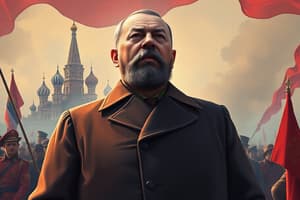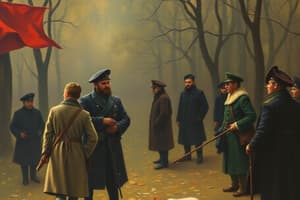Podcast
Questions and Answers
The February Revolution
The Russian army lost battle after battle in the ongoing First World War. The military losses precipitated the outbreak of the Revolution. Living conditions in the towns worsened due to food shortages and inflation. In Petrograd, workers went on strikes, and riots became common. Soldiers in Petrograd, finally, joined the people of the city. Eventually, Czar Nicholas II was deposed and this brought the rule of the Romanov Dynasty to an end After the monarchy was deposed in February 1917, the powerful members of the Duma (parliament) formed a Provisional Government led by George Lvov, who was succeeded by Alexander Kerensky However, the new government failed to meet the people's demands. It was unable to mitigate the food shortage and bring the war to an end. As a result, it lost support among the general public.
Meanwhile, in Petrograd, peasants, workers, and soldiers united together to form Soviets (councils or co-coordinating bodies) The Bolsheviks, led by Lenin, who had recently returned from exile, sought the dissolution of the incompetent Provisional Government.
History Grade 10
Student Testhock
As a result, it lost popular support. In the meantime, peasants, workers and soldiers in Petrograd came together and formed Soviets (councils or co-coordinating bodies). The Bolsheviks under Lenin, who had just returned from exile, demanded that the ineffective Provisional Government be dissolved.
The Bolsheviks held the following popular slogans "All Power to the Soviets!"
and "Peace, Land and Bread!" with these slogans and their organizing skills, the
Bolsheviks won popular support. In September 1917, a military take-over was attempted by
General Kornilov, the Commander-in-Chief of the Russian Army. Following the failure of
this attempt, the Bolsheviks strengthened their hold in Petrograd and Moscow where the
Soviets were strong
The February Revolution, in Petrograd, was a spontaneous
protest movement, inualuing huge masses of people The event was
characterized by massive strikes of workers and demonstrations, the
use of the army and the police to stop demonstrations and the
occupation of the State Duma in Petrograd. The period between
February and October 1917 was characterized by a dual power political
structure, representing the Provisional Government and the Petrograd Soviet
The February Revolution
The Russian army lost battle after battle in the ongoing First World War. The military losses precipitated the outbreak of the Revolution. Living conditions in the towns worsened due to food shortages and inflation. In Petrograd, workers went on strikes, and riots became common. Soldiers in Petrograd, finally, joined the people of the city. Eventually, Czar Nicholas II was deposed and this brought the rule of the Romanov Dynasty to an end After the monarchy was deposed in February 1917, the powerful members of the Duma (parliament) formed a Provisional Government led by George Lvov, who was succeeded by Alexander Kerensky However, the new government failed to meet the people's demands. It was unable to mitigate the food shortage and bring the war to an end. As a result, it lost support among the general public.
Meanwhile, in Petrograd, peasants, workers, and soldiers united together to form Soviets (councils or co-coordinating bodies) The Bolsheviks, led by Lenin, who had recently returned from exile, sought the dissolution of the incompetent Provisional Government.
History Grade 10
Student Testhock
As a result, it lost popular support. In the meantime, peasants, workers and soldiers in Petrograd came together and formed Soviets (councils or co-coordinating bodies). The Bolsheviks under Lenin, who had just returned from exile, demanded that the ineffective Provisional Government be dissolved.
The Bolsheviks held the following popular slogans "All Power to the Soviets!"
and "Peace, Land and Bread!" with these slogans and their organizing skills, the
Bolsheviks won popular support. In September 1917, a military take-over was attempted by
General Kornilov, the Commander-in-Chief of the Russian Army. Following the failure of
this attempt, the Bolsheviks strengthened their hold in Petrograd and Moscow where the
Soviets were strong
The February Revolution, in Petrograd, was a spontaneous
protest movement, inualuing huge masses of people The event was
characterized by massive strikes of workers and demonstrations, the
use of the army and the police to stop demonstrations and the
occupation of the State Duma in Petrograd. The period between
February and October 1917 was characterized by a dual power political
structure, representing the Provisional Government and the Petrograd Soviet
Flashcards are hidden until you start studying



